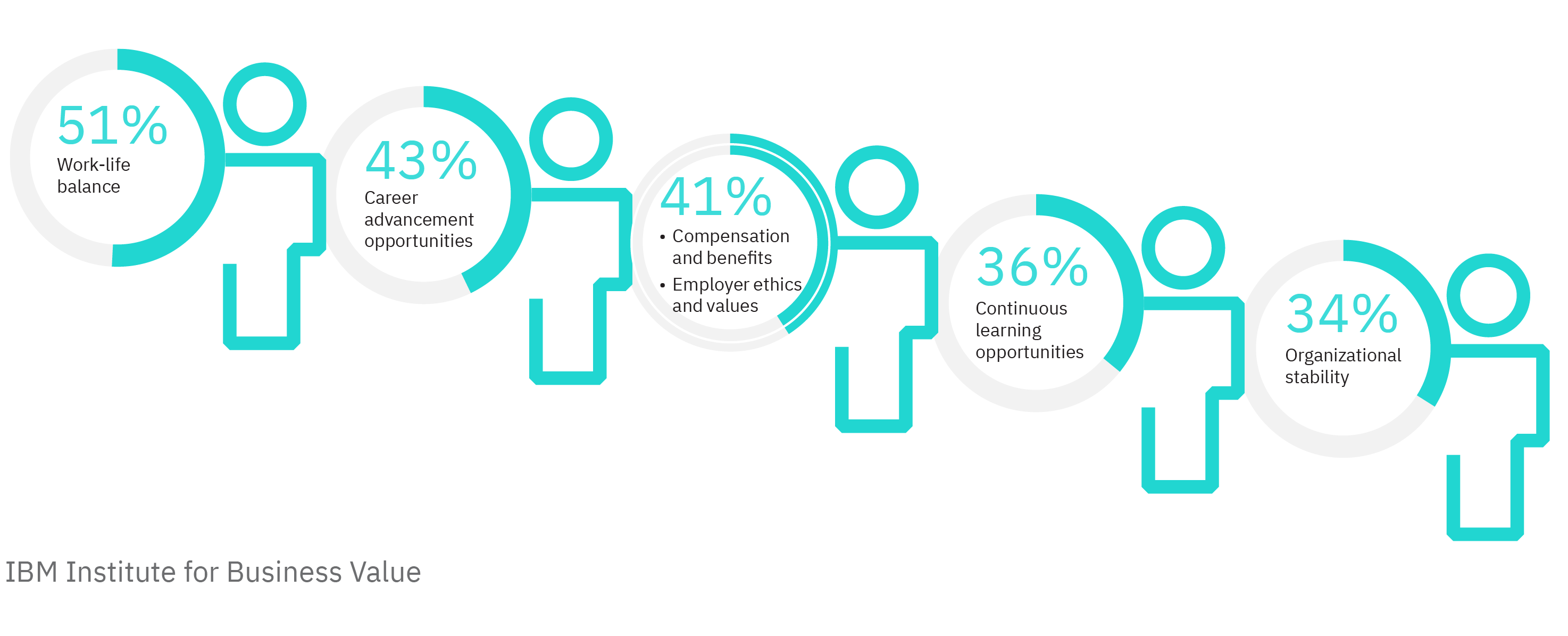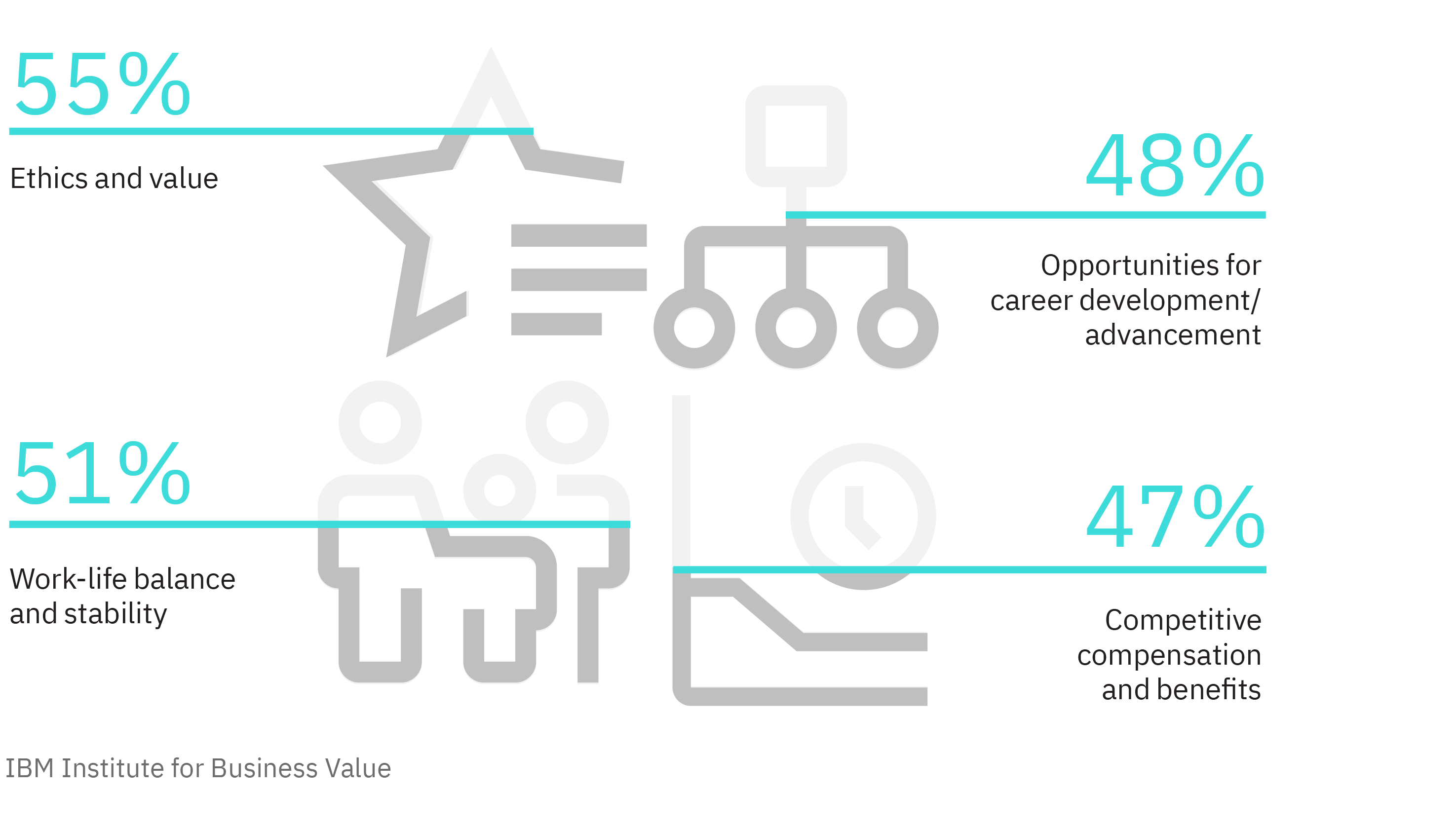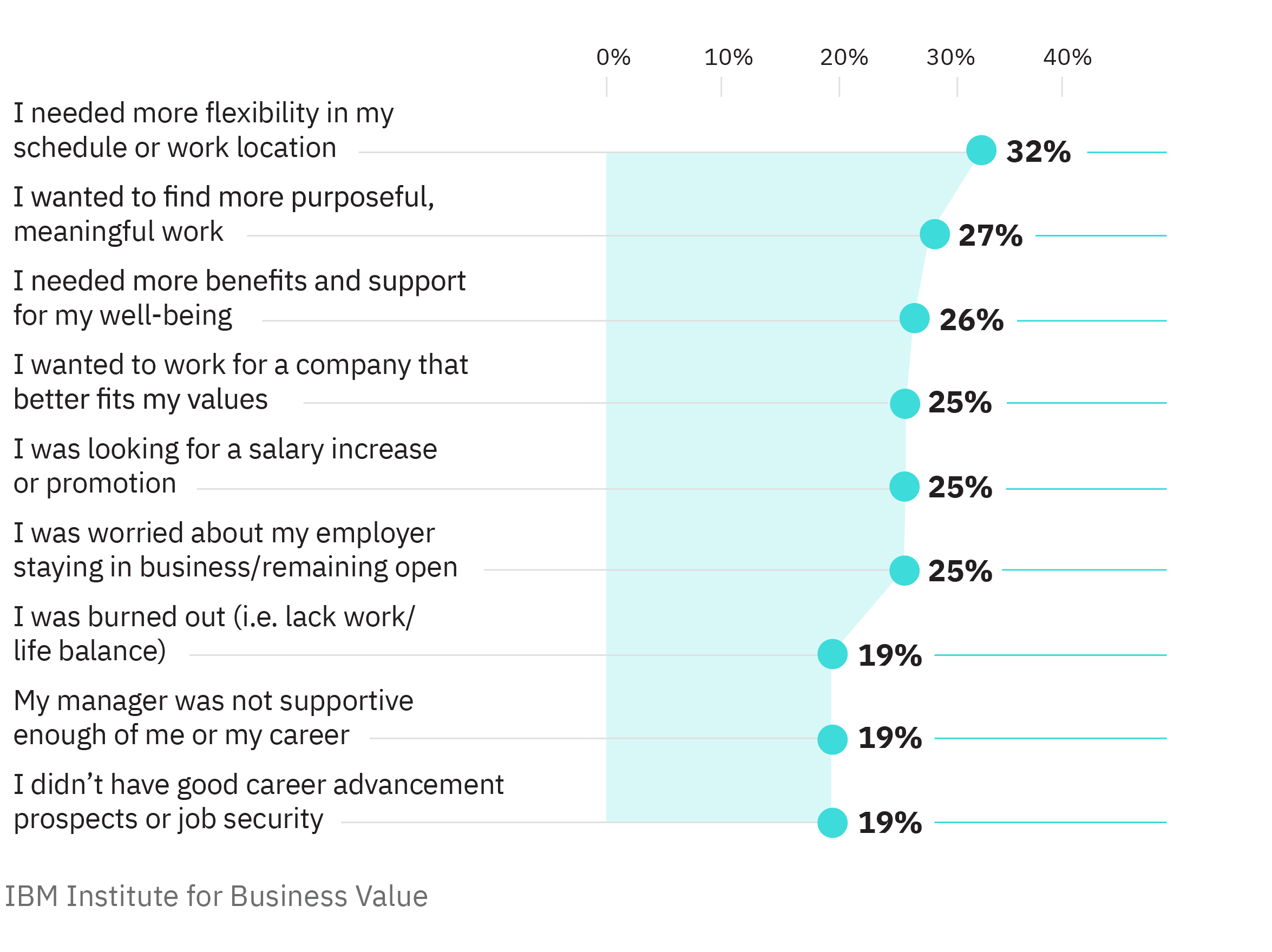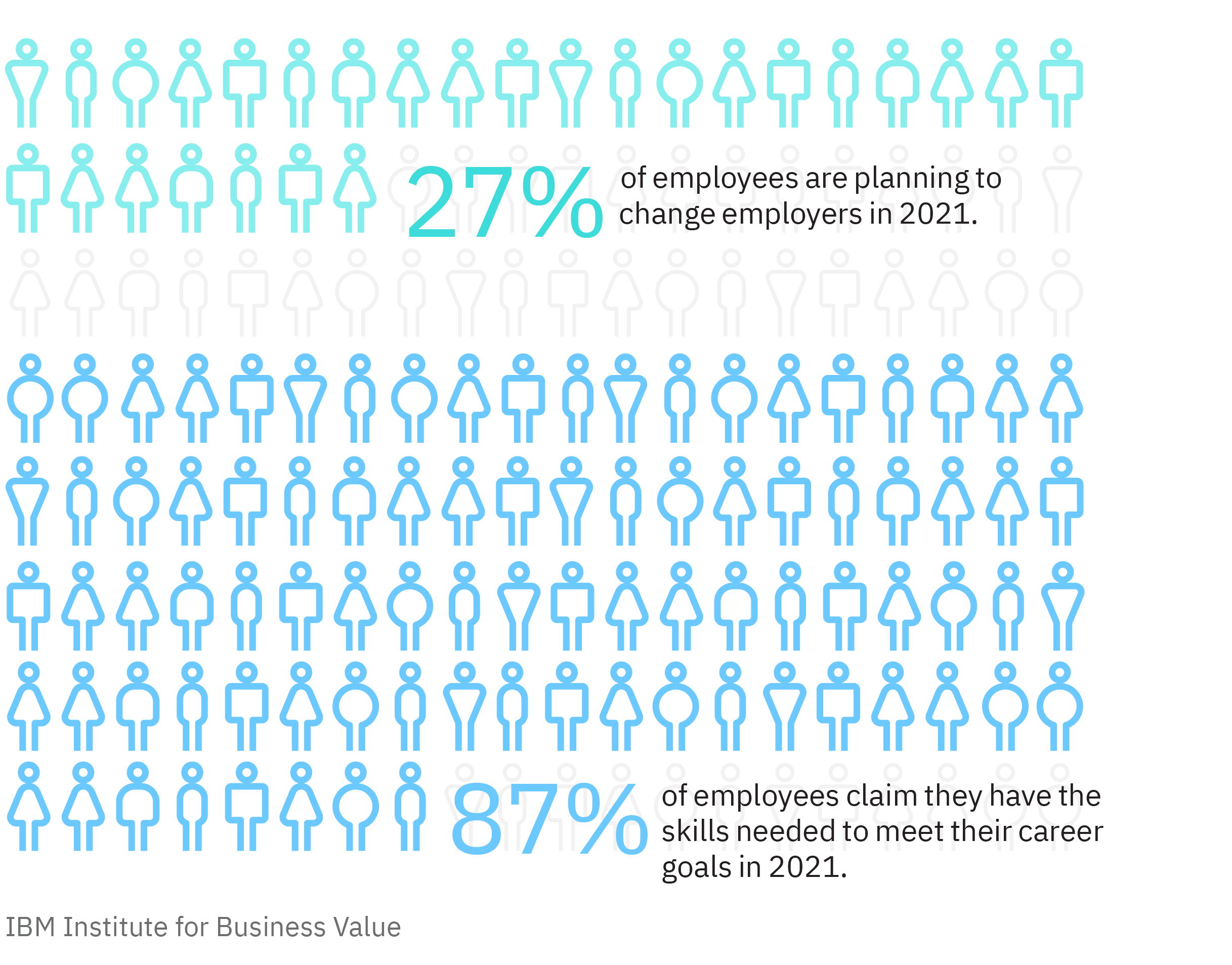About cookies on this site Our websites require some cookies to function properly (required). In addition, other cookies may be used with your consent to analyze site usage, improve the user experience and for advertising. For more information, please review your options. By visiting our website, you agree to our processing of information as described in IBM’sprivacy statement. To provide a smooth navigation, your cookie preferences will be shared across the IBM web domains listed here.
What employees expect in 2021
To retain top talent in the wake of COVID-19, employers need to understand employees’ evolving motivations and aspirations.
To retain top talent in the wake of COVID-19, employers need to understand employees’ evolving motivations and aspirations.
2020 is a year that will live in infamy. From lockdowns to layoffs, the pandemic wreaked havoc on every aspect of daily life. Companies and consumers cut corners to make ends meet—and hoped that relief would come quickly in 2021.
But as time marches on, uncertainty remains. Slow vaccine rollouts have delayed highly anticipated re-openings. Economic recovery has been hamstrung. And the global labor market, which shed the equivalent of 255 million full-time employees in 2020, could lose as many as 130 million more in 2021. In the US, women and people of color have borne the brunt of these losses, exacerbating the inequality that already exists in the workforce.
Fewer than 1 in 5 employees give their employers excellent marks for supporting worker well-being during the pandemic.
This turmoil continues to be traumatic for employees and executives alike. But nearly a year into the pandemic, it’s time to focus on the future. To better understand how employee perspectives shifted in 2020, as well as their motivations and aspirations for 2021, the IBM Institute for Business Value (IBV), in cooperation with Survey Monkey, surveyed more than 14,000 consumers across 9 countries in January.
We found that employees were generally satisfied with how their employers supported their well-being during the pandemic. Most employers received average or above-average marks for providing for the physical, mental, and financial well-being of employees. But fewer than 1 in 5 workers give excellent marks in any area.
This should give employers pause. While they met employee expectations last year, efforts that hit the bar in 2020 might fall short going forward. If executives want to retain top talent—particularly Gen Z and Millennials—they will need to understand employees’ evolving expectations, motivations, and aspirations for 2021.
What employees expect
Looking to the future, employee demands appear to be as diverse as the individuals themselves. When asked what employers should offer to engage employees, workers placed work-life balance (51%) and career advancement opportunities (43%) at the top of their list of priorities, with compensation and benefits (41%) and employer ethics and values (41%) following close behind. And more than a third of employees named continuous learning opportunities (36%) and organizational stability (34%) as key engagement factors.
Workers want it all: Employee expectations extend well beyond compensation.

This broad range of desires and expectations confirms that employees are looking for more than compensation from their employers. This is particularly true for younger workers. Only 29% of Gen Z indicated competitive salary and benefits were key to their engagement, compared to nearly half (49%) of those over 55.
When asked how well their employers were living up to these expectations, employees appeared underwhelmed. Only about half of workers gave their employers high marks on delivering what is most important to them across the board. While 55% of employees scored their employers highly in ethics and values, fewer than half were happy with career development and advancement opportunities (48%), and compensation and benefits packages (47%).
Delivery failure: Only about half of employees give their employers high grades on meeting expectations. Bridging the gap
Bridging the gap
To demonstrate that they are committed to supporting employees more holistically, some big-name brands have rolled out COVID relief programs aimed at boosting employee satisfaction, retention, and engagement. For example, in January, mega- retailer Target announced it would extend its coronavirus benefits into 2021. Free virtual healthcare, quarantine and confirmed illness pay, and a backup family care benefit were some of the offerings that drove the brand’s spending on employee health, safety, and wellbeing in 2020 up $1 billion over what it spent in 2019.
This type of employee-centric investment is one of the key factors that separate outperforming organizations from their peers, according to our 2021 IBM CEO Study. Outperformers, those that reported high revenue growth leading up to and during 2020, said they support employee well-being, even if it hurts profitability, 99% more often than their underperforming peers.
Outperforming CEOs said they support employee well-being—even if it hurts profitability—nearly twice as often as their underperforming peers.
But even when executives say they are supporting their employees, there may still be a gap that needs to be bridged. Recent IBV research found that while 80% of executives said their companies were supporting the physical and emotional health of employees, only 46% of employees agreed. Similarly, while 76% of executives said their organizations were providing adequate training on new ways to work during the pandemic, only 38% of employees said the same.
This level of misunderstanding can feel deeply frustrating to employees who have made clear requests and demands for what they need in the workplace. In our January 2021 survey, more than one-third of respondents indicated they and their colleagues have asked their employer for more flexible work arrangements, improved compensation and benefits, and more physical and financial safety and security in the past year. However, only about half of employees give employers high marks on their ability to deliver on what is most important to them.
Battling employee burnout
Closing this gap is key to attracting, retaining, and engaging employees in 2021. And that may require executives to rethink how supporting the workforce aligns with their other top priorities.
Our 2021 IBM CEO Study, for instance, found that business leaders are focused on accelerating their digital strategies, which they see as essential drivers of future success. As priorities have shifted due to COVID-19, organizational barriers to tech advancement have fallen by the wayside. And two-thirds of executives say that the pandemic has allowed them to advance specific transformation initiatives that previously had encountered resistance, according to recent IBV research.
Despite a massive global economic crisis, 1 in 5 employees voluntarily changed employers in 2020.
The opportunity to leap-frog forward is both exciting and essential—but the rapid ramp-up is also taking its toll on employees. September 2020 research from Microsoft found that 30% of global information and front-line workers say the pandemic has increased their feelings of burnout at work. Data compiled from Microsoft Teams shows that workers have been in significantly more meetings and managing more incoming chats—including twice as many after-hours messages.
This may start to explain why our survey found that, in the midst of a massive global economic crisis, 1 in 5 employees voluntarily changed employers in 2020. Together, Gen Z (33%) and Millennials (25%) accounted for more than half of these job-hopping respondents, demonstrating the urgent need for employers to find ways to retain young talent. Work location flexibility was the top reason people changed jobs (32%), with a desire to find more purposeful and meaningful work following close behind (27%). About 1 in 4 cited a desire for better benefits and support for their wellbeing, or they were looking for a salary increase or promotion.
In search of greener pastures: The pandemic didn’t stop employees from changing jobs in 2020. Looking farther into 2021, this trend seems to be intensifying. More than 1 in 4 employees are looking to make a move in 2021—and more than 60% of that group had already changed employers in January. Gen Z and Millennials make up the largest portion of this group.
Looking farther into 2021, this trend seems to be intensifying. More than 1 in 4 employees are looking to make a move in 2021—and more than 60% of that group had already changed employers in January. Gen Z and Millennials make up the largest portion of this group.
Those poised to leave their current jobs cited many of the same reasons as those who changed employers in 2020. However, salary increases and promotion opportunities jumped to the top of the list for 2021, with more than a third of respondents citing these financial motivators as the top reasons they want to make a career move. About 1 in 4 still identify support for well-being and a desire for more meaningful work as key motivators.
With this many employees looking for new opportunities in a tight labor market, executives should be wary of what will happen when hiring accelerates. And that may not be as far off as US government job figures make it seem. ManpowerGroup’s latest global employment outlook survey found that, from Q4 2020 to Q1 2021, hiring intentions improved in 32 of the 43 countries where employers were surveyed. And employees are confident in their abilities to land these new roles. According to our survey, 87% of employees claim they have the necessary skills to meet their job/employment goals in 2021.
On the hunt: A slow economic recovery hasn’t soured employee perspectives on job prospects. While this self-assessment may turn out to be a bit over-confident, organizations should be concerned about how a mass exodus of valuable talent could impact their future performance. Our 2021 IBM CEO Study found that outperforming CEOs see industry-specific skills (70%) and technology skills (69%) as critical to their success over the next 2 to 3 years—which puts a premium on retaining both industry veterans and digital natives.
While this self-assessment may turn out to be a bit over-confident, organizations should be concerned about how a mass exodus of valuable talent could impact their future performance. Our 2021 IBM CEO Study found that outperforming CEOs see industry-specific skills (70%) and technology skills (69%) as critical to their success over the next 2 to 3 years—which puts a premium on retaining both industry veterans and digital natives.
The key to success in 2021 likely comes down to communication. By building a dialogue and offering transparency into the decision-making process, companies have a chance to build deeper, more meaningful relationships with their employees. With the right intel, they can invest more in the initiatives their employees really want—and boost employee engagement and loyalty for the long term.
Action guide
Tips for employers:
1. Proactively engage with employees to better understand what is really important to them and their careers. Employees are more likely to be their authentic selves and open up when employers have created a culture of belonging. Employees have options. They will gravitate towards employers who are listening and taking action.
2. Foster a culture of perpetual learning that rewards continual skills growth. Most employees want to succeed and grow. Employers can either create learning cultures to nurture the skills and talents of their people, or wait for the exit interview to find out which of their competitors are.
3. Don’t take people for granted. The pandemic has reminded us how fragile life is. Everyone has been through a lot in the past year. Employers must demonstrate empathy and care for their employees holistically—by considering their physical, mental, and financial well-being.
Tips for employees:
1. Be your own advocate. You can’t expect your employer to know what is important to you if you don’t tell them. Be transparent and communicate your career goals clearly to your employer.
2. Commit to continuous learning. Ultimately, we are all accountable and responsible for our own careers and our own personal success. Skill requirements are changing rapidly. Keeping your skills current and relevant will be critical to your future career growth.
3. Don’t compromise on your values...or health. Most of us spend a majority of our adult lives working. We should all feel comfortable bringing our full selves to work every day without fear of judgment or retaliation. Research shows that people who live more authentically are prone to greater mental health—which generally equates to greater physical health. Many leading organizations and companies are working to create cultures of belonging to enable employees to be their authentic selves.
Bookmark this report
Share
Download report translations
Originally published 24 February 2021
How can IBM help you?
How can IBM help you?
You might also like





